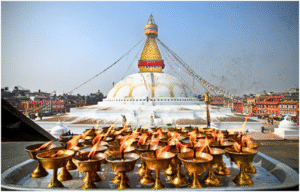
Epic Everest treks: Trekking the World’s Greatest Trail
The Everest region of Nepal, known as the Khumbu, is a sanctuary for trekkers looking to walk among the world’s most elevated mountains. Among the numerous treks here, four choices stand out: the classic Everest Base Camp trek, the effective but beautiful Everest Base Camp trek with Helicopter Return, the challenging and fulfilling Three Pass trek, and the time-optimized Everest Base Camp trek – 12 Days. Each offers an interesting way to involvement the magnificence of Everest and the warmth of Sherpa hospitality.
Trek Overviews
Everest Base Camp Trek
Duration: 14-16 Days
Difficulty: Moderate
Max Height: 5,364 m (Everest Base Camp)
Route Highlights: Lukla, Namche Bazaar, Tengboche, Dingboche, Lobuche, Gorakshep, Everest Base Camp, Kala Patthar
This is the quintessential Himalayan trek. It takes you from the bustling mountain airstrip of Lukla through the heart of Sherpa culture in Namche Bazaar and up to the notorious Everest Base Camp trek . Along the way, trekkers cross frosty streams, pass antiquated religious communities, and appreciate clearing sees of Everest, Lhotse, and Ama Dablam. Kala Patthar offers a climactic dawn display of Everest’s summit.
Everest Base Camp trek with Helicopter Return
Duration: 10-12 Days
Difficulty: Moderate
Max Elevation: 5,545 m (Kala Patthar)
Route Highlights: Same as classic EBC, but incorporates a helicopter flight from Gorakshep or Pheriche back to Kathmandu.
This adaptation of the trek combines the excitement of strolling to Everest Base Camp with the extravagance of a beautiful helicopter ride back. It’s idealized for those who need to preserve vitality, dodge a long plunge, or are brief on time. The helicopter return gives jaw-dropping airborne sees of Everest, ice sheets, and the Himalayan range.
Three Pass Trek
Duration: 18-21 Days
Difficulty: Challenging
Max Height: 5,545 m (Kala Patthar), 5,535 m (Kongma La), 5,420 m (Cho La), 5,360 m (Renjo La)
Route Highlights: Kongma La, Cho La, Renjo La, Everest Base Camp, Gokyo Lakes, Gokyo Ri, Namche
The Three Pass trek is for prepared trekkers. It joins the Everest Base Camp path with three tall passes, advertising a full-circle trek through the Everest region. It incorporates fabulous mountain amphitheaters, serene frosty lakes, and off-the-beaten-path Sherpa towns. With its tall elevation and specialized intersections, it’s a Himalayan experience at its finest.
Everest Base Camp trek – 12 Days
Duration: 12 Days
Difficulty: Moderate
Max Height: 5,545 m (Kala Patthar)
Route Highlights: Comparable to the classic course but compressed into less days with longer climbing durations.
This shorter variety of the classic Everest Base Camp trek – 12 Days is perfect for fit trekkers with restricted time. It incorporates all the primary highlights of the standard course, like Namche Bazaar, Tengboche Religious community, and Everest Base Camp, whereas trimming rest days and uniting the schedule. A speedier trek doesn’t cruelly lose out—it fairly implies strolling assist each day.
Highlights of the Everest region Treks
No matter which adaptation of the EBC course you select, the enchantment lies in the scene, individuals, and atmosphere.
Panoramic Mountain Sees: From the beginning with the sea of Everest close Namche to the unparalleled sees from Kala Patthar, you’re continually encompassed by snow-capped mammoths like Lhotse, Nuptse, Ama Dablam, and Thamserku.
Sherpa Culture: Visit dynamic towns like Namche Bazaar, antiquated religious communities like Tengboche, and remain in family-run teahouses that allow understanding into Sherpa hospitality.
High Passes and Frigid Lakes (Three Pass trek): Gokyo Lakes’ turquoise magnificence and the excitement of crossing passes like Cho La and Renjo La include measurement to the trek.
Helicopter Sees: A helicopter plunge offers magnificent airborne sees of the Khumbu Icefall and Everest itself.
Wildlife and Vegetation: See out for musk deer, Himalayan tahr, and fowls, along with rhododendron timberlands and elevated meadows.
Sample Itinerary Snapshots
Classic Everest Base Camp trek (16 Days)
Day 1: Fly to Lukla, trek to Phakding
Day 2: trek to Namche Bazaar
Day 3: Acclimatization at Namche
Day 4–7: Tengboche → Dingboche → Lobuche
Day 8: trek to Everest Base Camp
Day 9: Climb Kala Patthar
Day 10–13: Plunge through Pheriche, Namche, Lukla
Day 14: Fly to Kathmandu
EBC trek with Helicopter Return (12 Days)
Same as over until Day 9, then
Day 10: Helicopter from Gorak Shep or Pheriche to Kathmandu
Days 11–12: Rest or touring in Kathmandu
Three Pass trek (21 Days)
Adds days for the passes:
Trek incorporates alternate routes to Kongma La, Cho La, and Renjo La
Includes visit to Gokyo Lakes and Gokyo Ri
More acclimatization days and side hikes
Everest Base Camp trek – 12 Days
Removes one acclimatization day
Combines longer trekking days
Trek Difficulty and Preparation
Moderate (EBC, Helicopter Return, EBC-12 Days): Reasonable for trekkers with great wellness. Every day strolling 5–7 hours on well-maintained trails.
Challenging (Three Pass trek): Requests progressed wellness, acclimatization mindfulness, and involvement trekking at height. Crossing tall passes may include snow and essential scrambling.
Training Tips:
Cardiovascular wellness is fundamental (running, cycling, stair climbing).
Practice climbing with a stacked backpack.
Acclimatization climbs and earlier high-altitude involvement are important for Three Pass.
Best Time to Trek
The two best seasons are:
Spring (Walk to May): Rhododendron sprouts, clearer mornings, hotter days.
Autumn (September to November): Fresh skies, dry trails, wonderful visibility.
Avoid:
Summer (June–August): Storm downpours, landslides.
Winter (December–February): Exceptionally cold, snow squares passes.
Culture and People
The Everest region is the country of the Sherpa individuals, who take after Tibetan Buddhism. As you pass through towns like Namche, Dingboche, and Thame, you’ll experience supplication wheels, main dividers, and rippling supplication banners. Tengboche Religious community, set against a background of Ama Dablam, offers a minute of reflection and social inundation. The Sherpa neighborliness in teahouses is warm and genuine—expect healthy dal bhat, Tibetan bread, and stories of the mountains.
Permits and Logistics
Permits Required:
Sagarmatha National Stop Permit
Khumbu Pasang Lhamu Provincial Region Permit
TIMS Card (for Three Pass as it were or organized groups)
Getting There:
Most treks start with a flight from Kathmandu to Lukla (30–40 minutes).
Helicopter alternatives are accessible for higher-end or time-restricted travelers.
Accommodation:
Teahouses: Accessible all through the route—simple but comfortable.
Lodges in Gokyo and Dingboche: Regularly give way better views and calmer nights.
Essential Tips for a Safe Trek
Acclimatize appropriately: Take rest days at Namche and Dingboche.
Stay hydrated: Drink 3–4 liters per day.
Dress in layers: Climate changes quickly in the mountains.
Be adaptable: Flights to/from Lukla regularly confront delays due to weather.
Go guided if uncertain: A direct makes a difference with coordinations, culture, and safety.
Avoid height ailment: Know symptoms—headache, sickness, dizziness.
Final Thoughts:
Whether you’re in it for the full challenge of the Three Pass trek, the classic excellence of the Everest Base Camp trek, the quick fulfillment of the 12-Day EBC, or the airborne extravagance of a helicopter return, the Khumbu region has something exceptional for each kind of trekker. Each step is a journey into Nepal’s rough scenes, otherworldly heart, and versatile culture.
Now’s the time to select your path—and take after it all the way to Everest.
❓ Regularly Inquired Questions
Q: How long is the Everest Base Camp Trek?
A: The classic course takes 14–16 days. Speedier forms are 12 days, and extravagance heli return choices can be 10–12 days.
Q: Is the Three Pass trek harder than EBC?
A: Yes. The Three Pass trek includes three high-altitude intersections and requires way better wellness, acclimatization, and preparation.
Q: Can apprentices do the EBC trek?
A: Yes, if they are physically fit and take it moderate. Guided treks are prescribed for first-timers.
Q: Do I require travel insurance?
A: Completely. Guarantee it covers high-altitude trekking and helicopter evacuation.
Q: What’s the advantage of a helicopter return trek?
A: Spares time and dodges the long plunge. Furthermore, the airborne sees are phenomenal
Booking Process by Adventure Great Himalaya Treks:
To book any of these treks tours through Adventure Great Himalaya A Best Trekking Company In nepal ,To discuss your preferred dates, group size, and specific needs. They will provide a detailed itinerary covering these trek’s duration, highlights, cost, and inclusions such as a guide, porter, meals, accommodation, and transportation.
Prior to the trek, you will receive a comprehensive pre-trek briefing with essential information on packing, fitness preparation, and altitude acclimatization. The agency will finalize all logistical arrangements, including transportation, accommodation, and permits, to ensure everything is in place for your trek. Upon arrival in Nepal, the team will ensure that all aspects of the trek are organized, providing you with a smooth and unforgettable experience on these treks.


